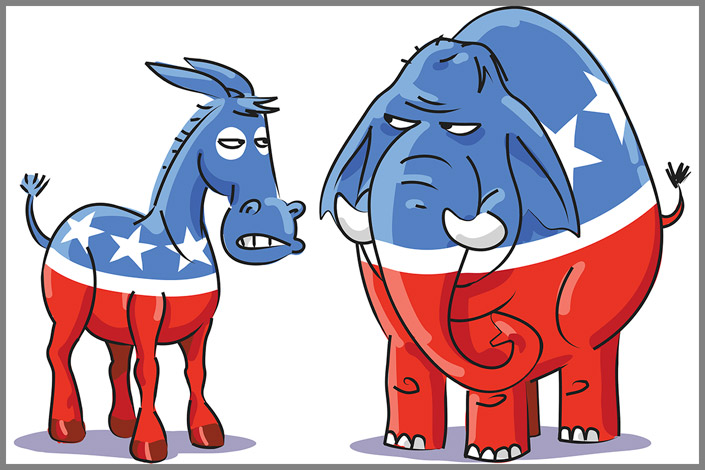Stanford experts discuss the deep political divide in the U.S. and what it may mean for the country's future
Historic presidential election reveals a country and its electoral system in turmoil, Stanford experts say.
Most political scientists and experts agree that the 2016 presidential election stands out for an unprecedented level of discord in the country’s political sphere.

Stanford experts see the 2016 election revealing deep discords and a party system in flux. (Image credit: kbeis / Getty Images)
“It’s a very, very significant and historic development, which not only suggests that our party system is in flux, but also that there is deep turbulence in the electorate,” said political science and sociology Professor Larry Diamond, a senior fellow at the Hoover Institution and at the Freeman Spogli Institute for International Studies.
Donald Trump’s victory over Hillary Clinton for president is the first time since 1940 that a major political party’s candidate had previously held no elected office or high-ranking governmental position.
Trump “changed the rules of political discourse and political campaigning,” said law Professor Nathaniel Persily. “He broke the mold as to what a viable candidacy entails.”
While Trump won the election, the American public expressed a record level of displeasure with both major party presidential candidates.
“There has never been a presidential election where you had such a high negative rating for both presidential candidates and where each candidate was distrusted by such high majorities of Americans,” Diamond said.
Diamond added that he couldn’t recall an election when “such a large swath of the intellectual and policy establishment explicitly rejected and denounced the candidacy of their party’s nominee,” noting that many members of the Republican leadership were critical of Donald Trump and his campaign.
The tone of the race for president also reached previously unseen levels of nastiness, according to some experts. “The level of personal vitriol has been sky high,” Diamond said. “We’ve just seen nothing like this.”
A divided country
Before Election 2016, political polarization was usually thought of as a term to describe the differences in party platforms between the Republicans and the Democrats.
This notion shifted with Trump’s candidacy this year, experts said.
“What Trump’s campaign has shown is the way we thought about polarization is too narrow,” Persily said. “Trump is about more than partisanship.”
For example, historically Republican candidates tended to be more pro-trade. They advocated for a tough stance against the country’s political adversaries and a stronger commitment to the U.S. allies than their Democratic counterparts.
“The Republican candidate is commonly seen as stronger on foreign policy and more willing to stand up to the Russians, to put it more crudely,” Diamond said.
This election cycle flipped those positions. The Democratic candidate was seen as advocating a tougher position when dealing with Russia, and the Republican was viewed as more anti-trade and anti-globalization, Diamond said.
It’s unclear yet how Trump’s campaign and political positions will affect the long-term future of the Republican Party. Some experts believe the division within the party is significant.
“There is a sense that (Republicans) lost control of the party to an insurgent who doesn’t share many of their principles and ideological beliefs,” said Diamond, comparing the 2016 election cycle to 1964, when Republican candidate Barry Goldwater also lacked support of his party’s establishment.
The prevalence of social media and its impact has contributed to further division and polarization of the U.S. electorate, experts said. “Because the news media is so fragmented, people opt into the social echo chambers that provide them the truth they want to hear,” Persily said.
Although the Internet provides an opportunity for education, it has also been used as a tool to spread false information. “Social media has had a very negative effect,” said Stanford political scientist Francis Fukuyama, the Mosbacher Director of the Center on Democracy, Development and the Rule of Law. “The total effect has been to move us toward what I call a post-fact world. And that’s a scary thought.”
Now experts are pondering what will happen next in this tense political climate.
A system in need of reform
The division and polarization are likely to persist and suggest a general unhappiness with the country’s political system.
“The American political system is in a lot of trouble,” said Fukuyama, who is also the Olivier Nomellini Senior Fellow at the Freeman Spogli Institute for International Studies. “It’s not an accident that people think it’s decayed or broken down.”
The country’s rising economic inequality and the frequent gridlock in the federal government are among the issues experts predict will continue to foment discord.
Bringing leaders of both parties together to reform the political system could help change the general sentiment, but it’s unlikely that partnership will happen, Persily said. “The American public is deeply divided in this election. This won’t disappear anytime soon.”
Diamond suggested the country look to Maine, which just passed a referendum for a statewide system of ranked-choice voting. Such a system may help alleviate the current polarization, he said. “The bottom line is: We need political reform. We need to work on civic education but we also need to reform the incentives that drive this polarization.”
